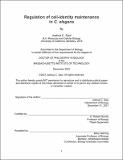Regulation of cell-identity maintenance in C. elegans
Author(s)
Saul, Joshua C.
DownloadThesis PDF (15.92Mb)
Advisor
Horvitz, H. Robert
Terms of use
Metadata
Show full item recordAbstract
Multicellular organisms are composed of a huge variety of different cell types, defined by their unique morphology, function, and gene expression. In animals, these characteristics are established during development, where internal and external cues guide the determination and differentiation of distinct cell identities. Following the establishment of a cell identity, that identity must be maintained for the remaining life of that cell. Maintenance requires both the continued expression of genes that define that terminally differentiated cell type, as well as suppression of the expression of genes that do not. Master transcriptional regulators are able to maintain the expression of genes in a terminally differentiated cell, though they can also drive the expression of additional undesired genes in a given cell type. The mechanisms by which the expression of these undesired genes is suppressed are poorly understood. In this dissertation, I describe genetic analyses of the nematode C. elegans that have provided insights into a mechanism that cells utilize to regulate gene expression and in turn maintain the identities of terminally differentiated cell types.
ctbp-1 is the sole worm ortholog of the C-terminal Binding Protein (CtBP) family of transcriptional corepressors. ctbp-1 mutants exhibit a disruption of normal gene expression in the bilaterally symmetric AIA interneurons. I characterized ctbp-1 mutant worms for aspects of AIA cell identity and found that ctbp-1 mutants display a progressively more severe disruption of AIA gene expression, morphology and function, defects characteristic of a loss of cell-identity maintenance. I screened ctbp-1 mutant worms for suppression of the loss of AIA cell identity and identified the transcription factor EGL-13. Characterization of egl-13 mutants suggests that CTBP-1 acts to maintain AIA cell identity in part by repressing the transcriptional activity of factors such as EGL-13, and, in the absence of CTBP-1, unregulated transcription factors drive defects in AIA gene expression, morphology, and function. My findings suggest that the repression of gene expression through the combined activity of transcriptional corepressors like CTBP-1 and transcription factors like EGL-13 might provide a mechanism through which the activation of gene expression by master transcriptional regulators is fine-tuned as part of proper cell-identity maintenance.
Date issued
2022-02Department
Massachusetts Institute of Technology. Department of BiologyPublisher
Massachusetts Institute of Technology